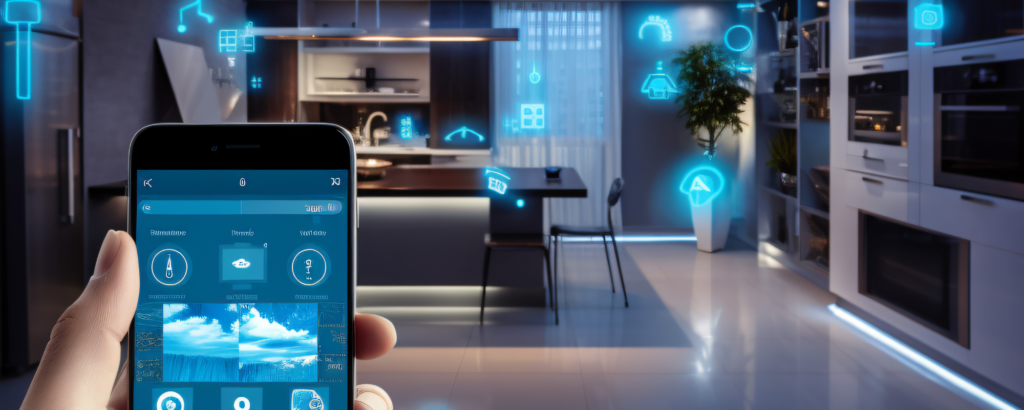Home automation is transforming the way we live, making homes smarter, more efficient, and secure. Whether it’s controlling lights with your voice, adjusting the thermostat remotely, or automating security systems, home automation offers convenience and control at your fingertips.

But what exactly is home automation, and how does it work? Let’s dive in!
What Is Home Automation?
Let’s start with the basics – what is home automation?
Home automation is a technology that lets users create and trigger automatic functions for home devices. That may be through schedules, rules, or scenes. With scheduled automations, for example, you can make lights turn on at a certain time. Using rules, you can make your devices respond to certain actions of yours or scenarios (e.g. turn on lights when a door is opened). And with scenes, you can group together home devices so each of them perform a specific action whenever you trigger the scene. That means you can control multiple devices with just a touch of a button.
Home automation makes life more convenient and can even save you money on heating, cooling and electricity bills. Home automation can also lead to greater safety with Internet of Things devices like security cameras and systems. But hold up; what’s the Internet of Things?
Key Features of Home Automation:
Remote Access: Control devices from anywhere using a mobile app.
Voice Control: Use Alexa, Google Assistant, or Siri to operate smart devices.
Scheduling & Automation: Set routines for lighting, temperature, and security.
Energy Efficiency: Optimize power usage and reduce energy bills.
Enhanced Security: Monitor your home through smart locks, cameras, and motion sensors.
How Does Home Automation Work?
Home automation relies on a network of smart devices connected via Wi-Fi, Bluetooth, or Zigbee that communicate with a central hub or a cloud-based system.
Main Components of a Smart Home System:
Smart Devices – Includes smart bulbs, thermostats, locks, cameras, and appliances.
Central Hub or App – A smart home hub (like Amazon Echo or Google Nest) connects and controls devices.
Wireless Communication – Devices use Wi-Fi, Zigbee, or Bluetooth for connectivity.
Automation & AI Integration – AI-powered assistants can predict and automate tasks.
For example, you can set your lights to turn on at sunset, your thermostat to adjust based on the weather, or your security cameras to send alerts when motion is detected.
Benefits of Home Automation
Convenience: Control your home with just a tap or voice command.
Safety & Security: Keep an eye on your home with real-time alerts.
Cost Savings: Smart thermostats and lighting reduce electricity costs.
Customization: Personalize automation settings based on your needs.
Is Home Automation Worth It?
Absolutely! Whether you’re looking for comfort, security, or energy savings, home automation is a game-changer. With advancements in technology, smart homes are becoming more accessible and affordable than ever.
Is Home Automation Secure? Tips for Securing IoT Devices
Home automation has revolutionized modern living, offering convenience, efficiency, and security. However, with smart home devices connected to the internet, cybersecurity risks also come into play. Hackers can exploit vulnerabilities in IoT (Internet of Things) devices, compromising privacy and security.
So, is home automation secure? The answer depends on how well you protect your devices and network. In this blog, we’ll explore home automation security risks and share essential tips to safeguard your smart home.
Understanding Home Automation Security Risks
Home automation systems rely on internet-connected devices such as smart cameras, door locks, thermostats, and lighting systems. While these devices enhance comfort, they also pose cybersecurity threats, including:
🔹 Unauthorized Access: Hackers may exploit weak passwords or security flaws to gain control of smart home devices.
🔹 Data Privacy Issues: Some smart devices collect personal data that can be misused if not properly secured.
🔹 Network Vulnerabilities: A weak home Wi-Fi network can serve as a gateway for cyberattacks.
🔹 Device Hijacking: Malicious actors can take over smart devices, such as cameras or voice assistants, for spying or other attacks.
Tips for Securing Your IoT Devices
To ensure your smart home remains protected, follow these security best practices:
1. Use Strong & Unique Passwords
Avoid default passwords and set strong, unique passwords for each smart device.
Use a password manager to store and manage complex passwords securely.
2. Enable Two-Factor Authentication (2FA)
Many smart home platforms offer 2FA, adding an extra layer of security.
This ensures that even if a password is compromised, unauthorized access is still prevented.
3. Keep Your Devices & Firmware Updated
Regularly update your smart devices to fix security vulnerabilities.
Enable automatic updates to ensure you always have the latest security patches.
4. Secure Your Wi-Fi Network
Change the default router name and password.
Use WPA3 encryption (or WPA2 if WPA3 isn’t available).
Create a separate network for IoT devices to isolate them from personal data.
5. Disable Unnecessary Features
Turn off remote access if not needed.
Disable voice assistant features on devices that don’t require them.
6. Use a Firewall & Antivirus Software
Install a firewall to block unauthorized access.
Use antivirus software to protect your network from malware.
7. Invest in a Secure Smart Home Hub
A smart home hub like Amazon Echo, Google Nest Hub, or Samsung SmartThings can centralize control while offering better security.
Choose a hub with strong encryption and security features.
8. Be Cautious with Third-Party Integrations
Only install apps and services from trusted sources.
Review app permissions and revoke access to unnecessary services.
Final Thoughts
While home automation brings convenience, it also requires strong security measures to prevent cyber threats. By following these best practices, you can enjoy the benefits of a smart home without compromising your privacy and security.
